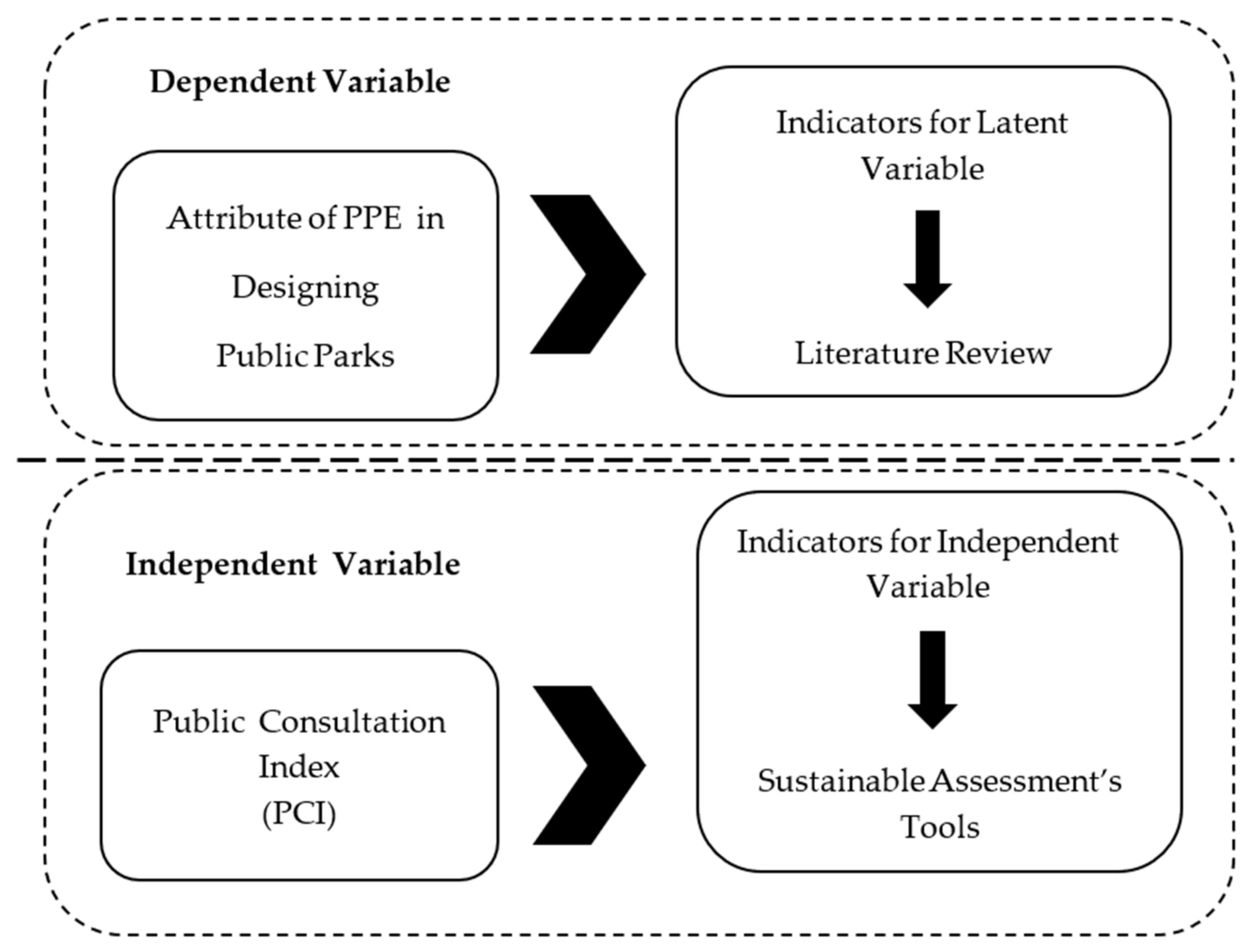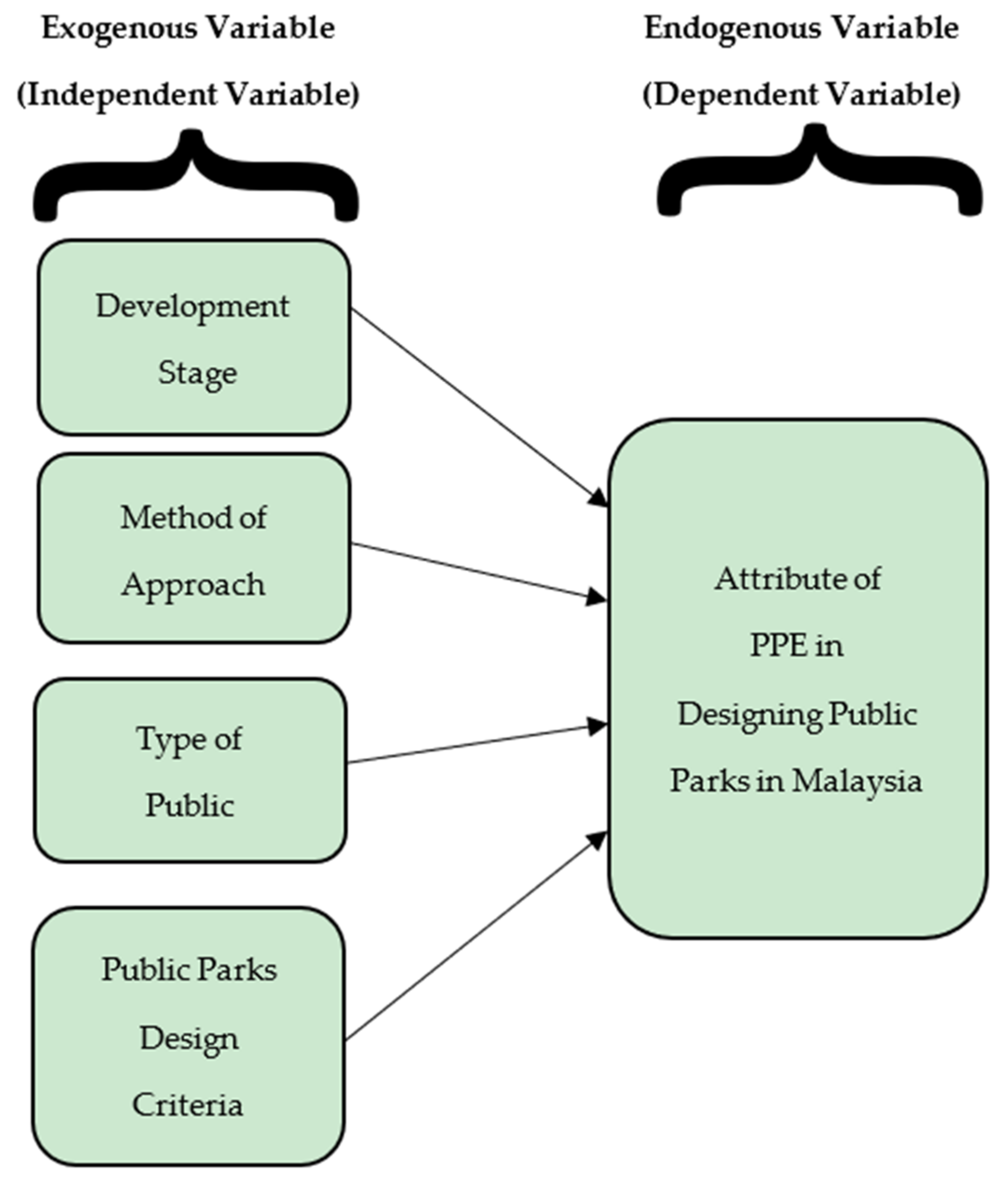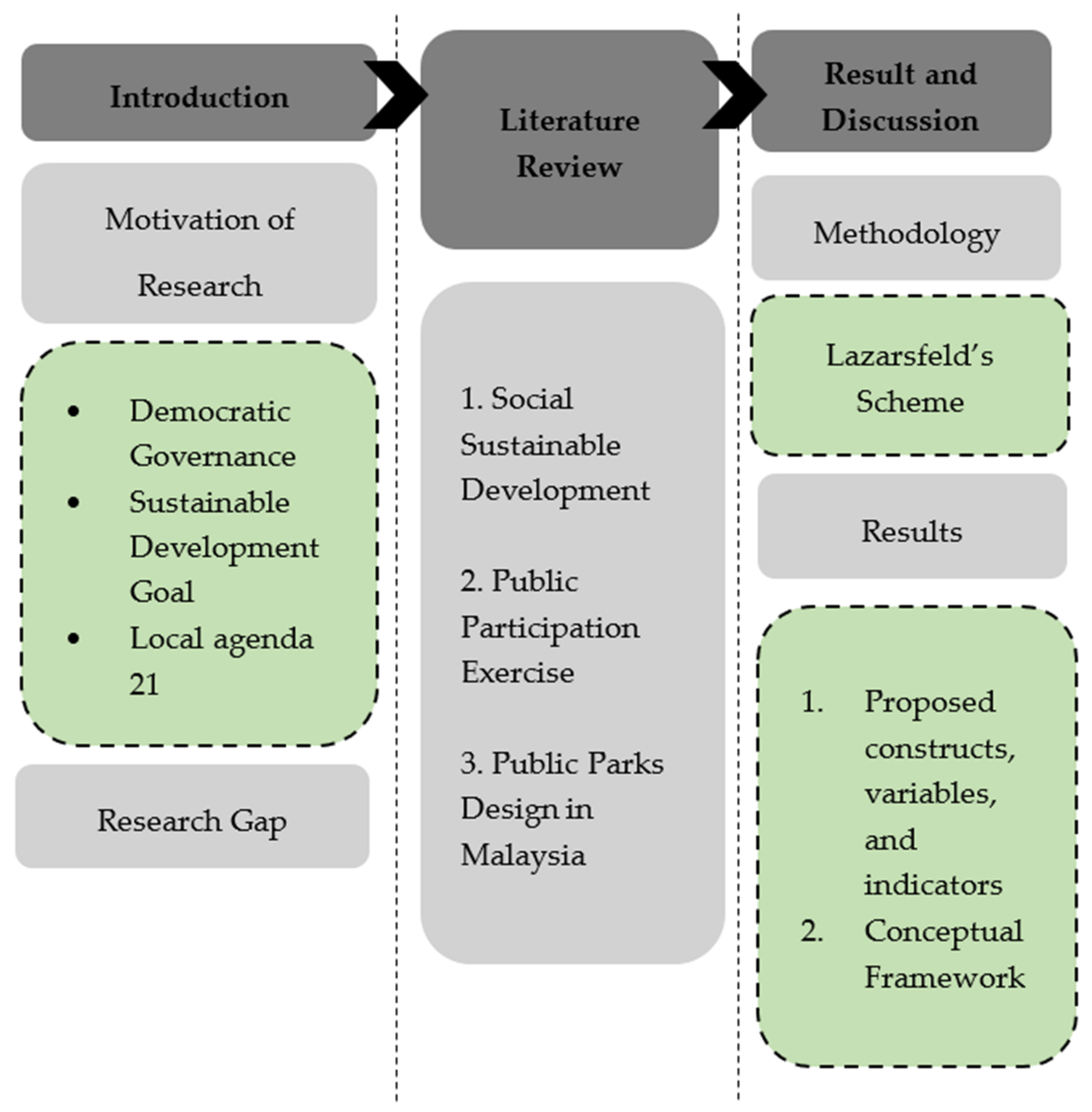Indicators of the Public Participation Exercise for Designing Public Parks in Malaysia: A Systematic Review
Abstract
1. Introduction
2. Literature Review
3. Public Participation Exercise—PPE
4. Sustainable Assessment’s Tool
- Leadership in Energy and Environmental Design Neighbourhood Development (LEED-ND)—United States [47].
- Building Research Establishment Environmental Assessment Method (BREEAM)—United Kingdom [48].
- Integrated Design Process (IDP)—Canada [49].
- Sustainable Site Initiative SITES v2 Rating System for sustainable land design and development—United States [50].
- Green Mark (For non-residential buildings NRB: 2015)—Singapore [51].
- Green Township Index (GTI)—Malaysia [52].
5. Public Parks Design in Criteria Malaysia—PPDCM
6. Methodology
7. Results and Discussion
8. Conclusions
Author Contributions
Funding
Conflicts of Interest
References
- Kamaruddin, N.; Rogers, R.A. Malaysia’s democratic and political transformation. Asian Aff. Am. Rev. 2020, 47, 126–148. [Google Scholar] [CrossRef]
- Moten, A.R. The 14th general elections in Malaysia: Ethnicity, party polarization, and the end of the dominant party system. Asian Surv. 2019, 59, 500–520. [Google Scholar] [CrossRef]
- Manaf, H.A.; Mohamed, A.M.; Lawton, A. Assessing Public Participation Initiatives in Local Government Decision-Making in Malaysia. Int. J. Public Adm. 2016, 39, 812–820. [Google Scholar] [CrossRef]
- Ghiasi, S.; Hassanzadeh, M.; Forghanifar, B. Role of Public Participation in Sustainable City. In Proceedings of the International Conference on Research in Science and Technology, Kuala Lumpur, Malasya, 15 December 2015. [Google Scholar]
- Eckerd, A.; Heidelberg, R.L. Administering Public Participation. Am. Rev. Public Adm. 2019, 50, 133–147. [Google Scholar] [CrossRef]
- Feng, L.; Wu, Q.; Wu, W.; Liao, W. Decision-Maker-Oriented VS. Collaboration: China’s Public Participation in Environmental Decision-Making. Sustainability 2020, 12, 1334. [Google Scholar] [CrossRef]
- Liu, L.; Chen, J.; Cai, Q.; Huang, Y.; Lang, W. System Building and Multistakeholder Involvement in Public Participatory Community Planning through Both Collaborative- and Micro-Regeneration. Sustainability 2020, 12, 8808. [Google Scholar] [CrossRef]
- Santé, I.; Fernández-Ríos, A.; Tubío, J.M.; García-Fernández, F.; Farkova, E.; Miranda, D. The Landscape Inventory of Galicia (NW Spain): GIS-web and public participation for landscape planning. Landsc. Res. 2018, 44, 212–240. [Google Scholar] [CrossRef]
- Pløger, J. Politics, planning, and ruling: The art of taming public participation. Int. Plan. Stud. 2021, 26, 426–440. [Google Scholar] [CrossRef]
- Bidwell, D.; Schweizer, P. Public values and goals for public participation. Environ. Policy Gov. 2021, 31, 257–269. [Google Scholar] [CrossRef]
- United Nations World Commission on Environment and Development. Report of the World Commission on Environment and Development: Our Common Future; Oxford University Press: Oxford, UK, 1987; Volume 10, pp. 1–300. [Google Scholar]
- Kadir, S.A.; Jamaludin, M. Universal Design as a Significant Component for Sustainable Life and Social Development. Procedia-Soc. Behav. Sci. 2013, 85, 179–190. [Google Scholar] [CrossRef]
- Fonseca, L.M.; Domingues, J.P.; Dima, A.M. Mapping the Sustainable Development Goals Relationships. Sustainability 2020, 12, 3359. [Google Scholar] [CrossRef]
- UN-DESA. Sustainable Development Goals. 2021. Available online: https://sdgs.un.org/goals (accessed on 11 October 2021).
- Abidin, N.I.; Zakaria, R.; Aminuddin, E.; Saar, C.C.; Munikanan, V.; Zin, I.S.; Bandi, M. Malaysia’s Local Agenda 21: Implementation and approach in Kuala Lumpur, Selangor and Johor Bahru. IIOAB J. 2016, 7, 554–562. [Google Scholar]
- Nurudin, S.M.; Hashim, R.; Rahman, S.; Zulkifli, N.; Mohamed, A.S.P.; Hamik, S.A. Public Participation Process at Local Government Administration: A Case Study of the Seremban Municipal Council, Malaysia. Procedia-Soc. Behav. Sci. 2015, 211, 505–512. [Google Scholar] [CrossRef][Green Version]
- Hassan, A.M.; Lee, H. The paradox of the sustainable city: Definitions and examples. Environ. Dev. Sustain. 2014, 17, 1267–1285. [Google Scholar] [CrossRef]
- Ngah, K.; Mustaffa, J.; Zakaria, Z.; Noordin, N.; Sawal, M.Z.H.M. Formulation of Agenda 21 Process Indicators for Malaysia. J. Manag. Sustain. 2011, 1, 82. [Google Scholar] [CrossRef][Green Version]
- Ujang, N.; Moulay, A.; Zakariya, K. Sense of Well-Being Indicators: Attachment to public parks in Putrajaya, Malaysia. Procedia-Soc. Behav. Sci. 2015, 202, 487–494. [Google Scholar] [CrossRef]
- Moulay, A.; Ujang, N. Insight into the issue of underutilised parks: What triggers the process of place attachment? Int. J. Urban Sustain. Dev. 2021, 13, 297–316. [Google Scholar] [CrossRef]
- Ibrahim, R.; Clayden, A.; Cameron, R. Tropical urban parks in Kuala Lumpur, Malaysia: Challenging the attitudes of park management teams towards a more environmentally sustainable approach. Urban For. Urban Green. 2020, 49, 126605. [Google Scholar] [CrossRef]
- Gorgul, E.; Luo, L.; Wei, S.; Pei, C.D. Sense of Place or Sense of Belonging? Developing Guidelines for Human-centered Outdoor Spaces in China that Citizens Can be Proud of. Procedia Eng. 2017, 198, 517–524. [Google Scholar] [CrossRef]
- Ridings, J.; Chitrakar, R.M. Urban design frameworks, user activities and public tendencies in Brisbane’s urban squares. Urban Des. Int. 2021, 26, 272–288. [Google Scholar] [CrossRef]
- UNDP. Human Development Report 2020. Available online: https://report.hdr.undp.org/ (accessed on 10 October 2021).
- Too, L.; Bajracharya, B. Sustainable campus: Engaging the community in sustainability. Int. J. Sustain. High. Educ. 2015, 16, 57–71. [Google Scholar] [CrossRef]
- Karji, A.; Woldesenbet, A.; Khanzadi, M.; Tafazzoli, M. Assessment of Social Sustainability Indicators in Mass Housing Construction: A Case Study of Mehr Housing Project. Sustain. Cities Soc. 2019, 50, 101697. [Google Scholar] [CrossRef]
- Berke, P.R.; Conroy, M.M. Are we planning for sustainable development? An evaluation of 30 comprehensive plans. J. Am. Plan. Assoc. 2000, 66, 21–33. [Google Scholar] [CrossRef]
- Dempsey, N.; Bramley, G.; Power, S.; Brown, C. The social dimension of sustainable development: Defining urban social sustainability. Sustain. Dev. 2011, 19, 289–300. [Google Scholar] [CrossRef]
- Power, A. Sustainable Communities and Sustainable Development: A Review of the Sustainable Communities Plan; Sustainable Development Commission: London, UK, 2004; pp. 1–36. [Google Scholar]
- Christoffersen, S.E.; Sarkissian, S. City size and fund performance. J. Financ. Econ. 2009, 92, 252–275. [Google Scholar] [CrossRef]
- Magis, K. Community Resilience: An Indicator of Social Sustainability. Soc. Nat. Resour. 2010, 23, 401–416. [Google Scholar] [CrossRef]
- UNPAG. UN Public Administration Glossary. 2013. Available online: http://www.unpog.org/page/sub5_3.asp (accessed on 12 December 2020).
- Ahmadi, D.; Bandung, I.U.I.; Rachmiatie, A.; Nursyawal. Public Participation Model for Public Information Disclosure. J. Komun. Malays. J. Commun. 2019, 35, 305–321. [Google Scholar]
- Jibladze, G.; Romelashvili, E.; Chkheidze, A.; Modebadze, E.; Mukeria, M. Assessing Public Participation in Policymaking Process; WeResearch: Tbilisi, Georgia, 2021; pp. 1–52. [Google Scholar]
- Jekabsone, I.; Sloka, B. The role of municipality in promotion of well-being: Development of public services. In Economic and Social Development: Book of Proceedings; Varazdin Development and Entrepreneurship Agency: Varazdin, Croatia, 2017; pp. 713–721. [Google Scholar]
- Wampler, B.; Touchton, M. Designing institutions to improve well-being: Participation, deliberation and institutionalisation. Eur. J. Polit. Res. 2019, 58, 915–937. [Google Scholar] [CrossRef]
- Amoah, P.A. Social participation, health literacy, and health and well-being: A cross-sectional study in Ghana. SSM-Popul. Health 2018, 4, 263–270. [Google Scholar] [CrossRef] [PubMed]
- Payne, S.; Mackrill, J.; Cain, R.; Strelitz, J.; Gate, L. Developing interior design briefs for health-care and well-being centres through public participation. Arch. Eng. Des. Manag. 2015, 11, 264–279. [Google Scholar] [CrossRef]
- García, N.A.A.; Pazmiño, M.G. Principios de sostenibilidad social en el diseño urbano. Rev. Científica Retos Cienc. 2018, 2, 1–11. [Google Scholar]
- Yuliani, S.; Hardiman, G.; Setyowati, E. Green-Roof: The Role of Community in the Substitution of Green-Space toward Sustainable Development. Sustainability 2020, 12, 1429. [Google Scholar] [CrossRef]
- Grimmer, A.; Wille, R. Designing Droplet Microfluidic Networks; Springer: Berlin/Heidelberg, Germany, 2020. [Google Scholar]
- Ali, M.A.M.; Arifin, K. Penglibatan Awam Sebagai Pembuat Keputusan Dalam Rancangan Tempatan Pihak Berkuasa Tempatan (Public Participation as a Decision Maker in Local Plans at Local Authority). Akademika 2020, 90, 151–163. [Google Scholar]
- Siew, R.Y.J. Green Township Index: Malaysia’s sustainable township rating tool. In Proceedings of the Institution of Civil Engineers-Engineering Sustainability; Thomas Telford Ltd.: London, UK, 2017. [Google Scholar]
- Yan, Y.; Shan, P.; Wang, C.; Quan, Y.; Wu, D.; Zhao, C.; Wu, G.; Deng, H. Assessment of urban sustainability efficiency based on general data envelopment analysis: A case study of two cities in western and eastern China. Environ. Monit. Assess. 2017, 189, 191. [Google Scholar] [CrossRef] [PubMed]
- Wu, G.; Qiang, G.; Zuo, J.; Zhao, X.; Chang, R. What are the Key Indicators of Mega Sustainable Construction Projects?—A Stakeholder-Network Perspective. Sustainability 2018, 10, 2939. [Google Scholar] [CrossRef]
- Larco, N. Sustainable urban design—A (draft) framework. J. Urban Des. 2016, 21, 1–29. [Google Scholar] [CrossRef]
- LEED-ND. Leadership in Energy and Environmental Design Neighbourhood Development 2021. Available online: http://leed.usgbc.org/nd.html (accessed on 5 January 2021).
- BREEAM. Building Research Establishment Environmental Assessment Method. 2021. Available online: https://www.bregroup.com/greenguide/calculator/page.jsp?id=2071 (accessed on 28 March 2021).
- IDP. The Integrated Design Process. 2021. Available online: http://iisbe.org/down/gbc2005/Other_presentations/IDP_overview.pdf (accessed on 22 March 2021).
- SITES-V2. The Sustainable Sites Initiative. 2021. Available online: http://www.sustainablesites.org/get-started-sites-v2-rating-system (accessed on 18 March 2021).
- GreenMark. Green Mark for Non-Residential Building NRB: 2015. 2015. Available online: https://www.bca.gov.sg/greenmark/others/Green_Mark_NRB_2015_Criteria_Draft_R3.pdf (accessed on 7 April 2021).
- GBI. GBI Assessment Criteria for Township. 2017. Available online: https://www.greenbuildingindex.org/Files/Resources/GBI%20Tools/GBI%20Township%20Tool%20V2.0.pdf (accessed on 16 January 2021).
- Adiati, M.; Lestari, N.; Wiastuti, R. Public parks as urban tourism in Jakarta. In IOP Conference Series: Earth and Environmental Science; IOP Publishing: Bristol, UK, 2018. [Google Scholar]
- Ahmad, M.H. Project Review: Public Park Planning and Design as Contribution from Multidiscipline Fields in Built Environment. J. Alam Bina 2006, 8, 39–46. [Google Scholar]
- Sakip, S.R.M.; Akhir, N.M.; Omar, S.S. Determinant Factors of Successful Public Parks in Malaysia. Procedia-Soc. Behav. Sci. 2015, 170, 422–432. [Google Scholar] [CrossRef]
- Sakip, S.R.M.; Akhir, N.M.; Omar, S.S. The Influential Factors of Successful Public Parks in Malaysia. Asian J. Behav. Stud. 2018, 3, 195–205. [Google Scholar] [CrossRef]
- Grilli, G.; Mohan, G.; Curtis, J. Public park attributes, park visits, and associated health status. Landsc. Urban Plan. 2020, 199, 103814. [Google Scholar] [CrossRef]
- Ngesan, M.R.; Karim, H.A.; Zubir, S.S.; Ahmad, P. Urban Community Perception on Nighttime Leisure Activities in Improving Public Park Design. Procedia-Soc. Behav. Sci. 2013, 105, 619–631. [Google Scholar] [CrossRef]
- Fu, Y.; Ma, W. Sustainable Urban Community Development: A Case Study from the Perspective of Self-Governance and Public Participation. Sustainability 2020, 12, 617. [Google Scholar] [CrossRef]
- Tomlinson, C. City of culture, city of transformation: Bringing together the urban past and urban present in The Hull Blitz Trail. Urban Hist. 2020, 48, 351–363. [Google Scholar] [CrossRef]
- Brown, G.; Schebella, M.; Weber, D. Using participatory GIS to measure physical activity and urban park benefits. Landsc. Urban Plan. 2014, 121, 34–44. [Google Scholar] [CrossRef]
- JPBD. Perancang Bandar Dan Desa. 2016. Available online: https://www.townplan.gov.my/index.php?option=com_docman&view=flat&layout=table&category%5B0%5D=48&category_children=1&own=0&Itemid=427&lang=ms&limit=20&limitstart=20 (accessed on 24 January 2021).
- UNSDG. Sustainable Development. 2019. Available online: https://sustainabledevelopment.un.org/partnerships/ (accessed on 10 October 2021).
- Bakar, J.A. A Design Guide of Public Parks in Malaysia; Penerbit UTM: Johor Bahru, Malaysia, 2002. [Google Scholar]
- Ahmad, M.H. The Architecture of Public Park: Fading the Line between Architecture and Landscape. J. Alam Bina 2006, 8, 61–82. [Google Scholar]
- Khaza, M.K.B.; Rahman, M.; Harun, F.; Roy, T.K. Accessibility and Service Quality of Public Parks in Khulna City. J. Urban Plan. Dev. 2020, 146, 04020024. [Google Scholar] [CrossRef]
- Vallance, S.; Perkins, H.C.; Dixon, J.E. What is social sustainability? A clarification of concepts. Geoforum 2011, 42, 342–348. [Google Scholar] [CrossRef]




| Variable | Criteria |
|---|---|
| Announcement |
|
| Consultation Format |
|
| Feedback |
|
| Stages of Policy Development |
|
| Participants |
|
| Terms | Definition of Terms | Reference |
|---|---|---|
| Public Participation | Citizen participation implies the involvement of citizens in a wide range of policymaking activities, including the determination of levels of service, budget priorities, and the acceptability of physical construction projects in order to orient government programs toward community needs, build public support, and encourage a sense of cohesiveness within neighbourhoods. | [63] |
| Public Parks | The term ‘park’ is frequently used in connection with open spaces. Park and green areas are part of an element of recreation and relaxation. Public parks are essentially linked to open space and recreation activities. | [53,64,65] |
| Variables | Construct and Operationalised Definition | Item Measurement | Indicator | Adapted Sources |
|---|---|---|---|---|
| Attributes of PPE in Designing Public Parks in Malaysia | Public Participation | Public perception towards the attributes of PPE in designing public parks in Malaysia |
| [1,2,5,6,7,8,10,14,18,19,24,30,31,33,35,36,38,40] |
| 1. Development Stage (DS) | Public Participation | Public opinion on the development stage |
| [34,38,47,48,49,50,51,52] |
| 2. Method of Approach (MA) | Public Participation | Public opinion on the method of approach |
| [34,35,38,47,48,49,50,51,52] |
| 3. Type of Public (TP) | Public Participation | Public opinion on the type of public |
| [34,47,48,49,50,51,52] |
| Public Parks Design Criteria (PPDC) | Public Parks | Public opinion on the design factor in designing public parks |
| [23,25,55,57,58,59,65,66,67] |
Publisher’s Note: MDPI stays neutral with regard to jurisdictional claims in published maps and institutional affiliations. |
© 2021 by the authors. Licensee MDPI, Basel, Switzerland. This article is an open access article distributed under the terms and conditions of the Creative Commons Attribution (CC BY) license (https://creativecommons.org/licenses/by/4.0/).
Share and Cite
Sonet, U.N.; Klufallah, M.; Peters, M.D.; Dixon, T.J. Indicators of the Public Participation Exercise for Designing Public Parks in Malaysia: A Systematic Review. Sustainability 2021, 13, 12119. https://doi.org/10.3390/su132112119
Sonet UN, Klufallah M, Peters MD, Dixon TJ. Indicators of the Public Participation Exercise for Designing Public Parks in Malaysia: A Systematic Review. Sustainability. 2021; 13(21):12119. https://doi.org/10.3390/su132112119
Chicago/Turabian StyleSonet, Ungku Norani, Mustafa Klufallah, Michael D. Peters, and Timothy J. Dixon. 2021. "Indicators of the Public Participation Exercise for Designing Public Parks in Malaysia: A Systematic Review" Sustainability 13, no. 21: 12119. https://doi.org/10.3390/su132112119
APA StyleSonet, U. N., Klufallah, M., Peters, M. D., & Dixon, T. J. (2021). Indicators of the Public Participation Exercise for Designing Public Parks in Malaysia: A Systematic Review. Sustainability, 13(21), 12119. https://doi.org/10.3390/su132112119







